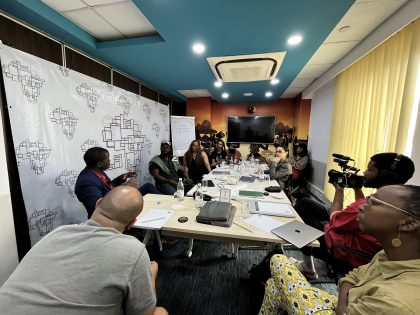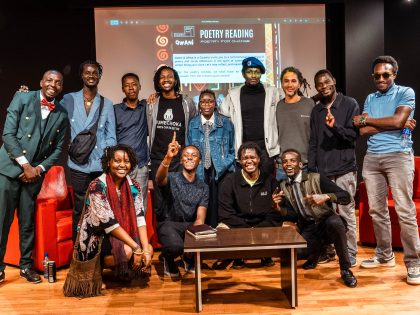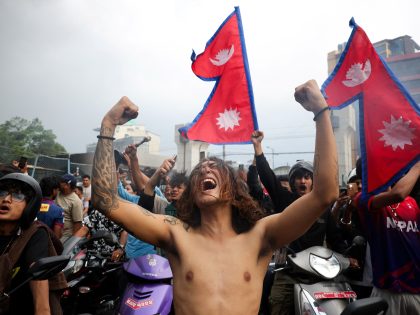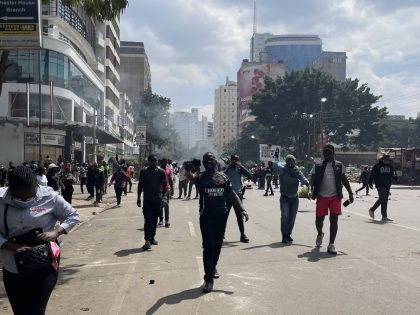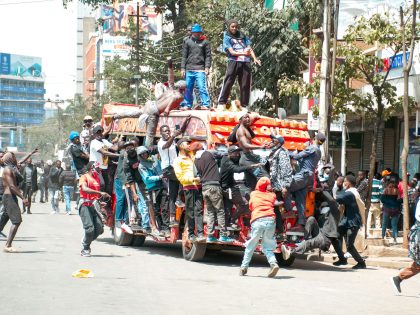Hospitals versus stadiums
As Morocco prepares to host AFCON and the 2030 World Cup, a decentralized youth movement is demanding real investment in public services over sporting spectacle.
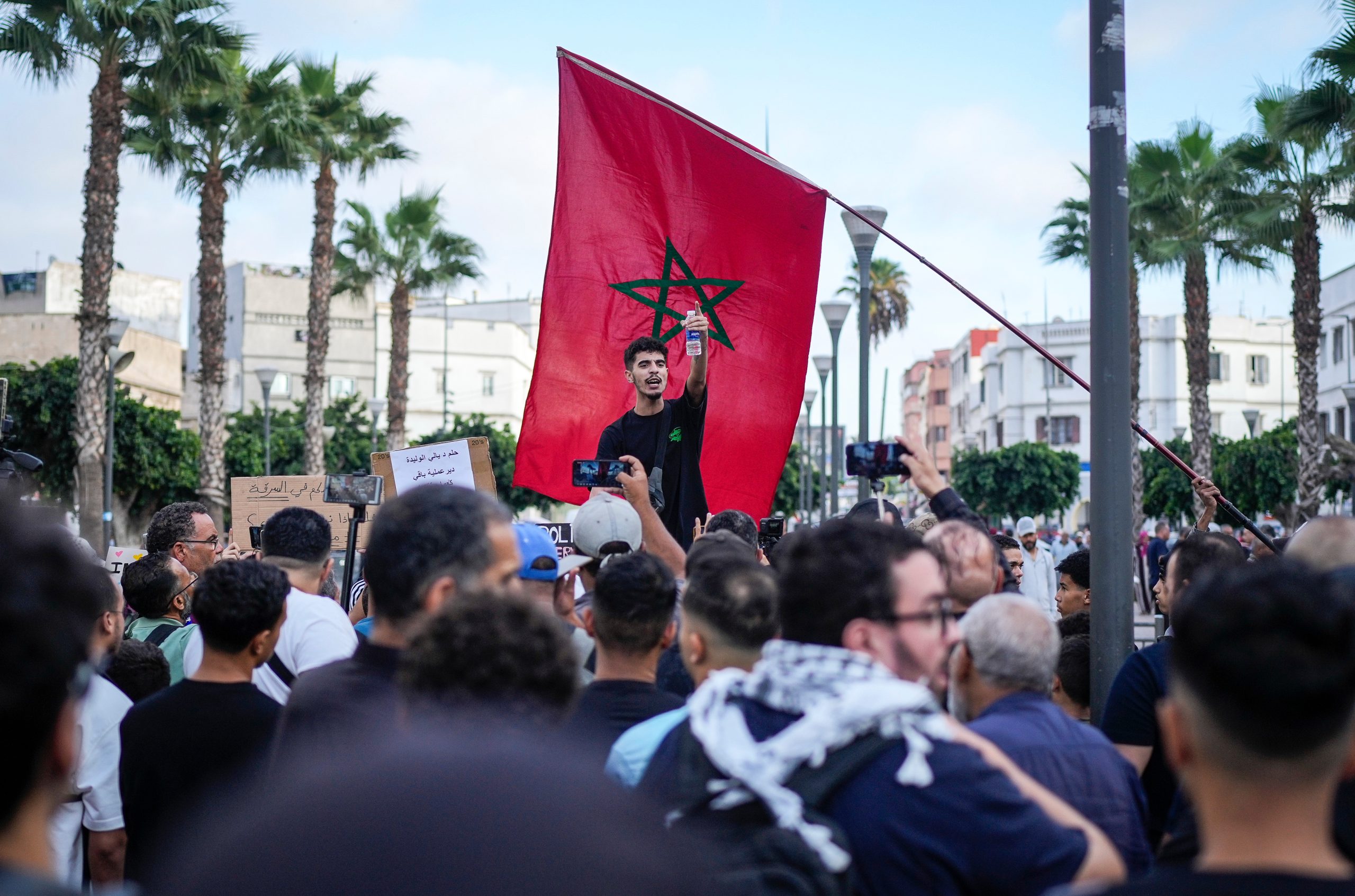
People take part in a youth led protest against corruption and calling for healthcare and education reforms, in Casablanca, Morocco, Sunday, Oct. 5, 2025. (AP Photo/Mosa'ab Elshamy)
“The images are going viral around the world, just as Morocco is set to host the Africa Cup of Nations in December,” says Othman, a fellow journalist and film director based in Rabat. For six days, peaceful demonstrations led by Morocco’s Generation Z unfolded across the country. But by Tuesday, September 30, tensions escalated into clashes with police. The Ministry of the Interior reported 409 arrests and around 300 injuries—most of them among law enforcement.
On Wednesday, October 1, three people were killed by police after attempting to storm a gendarmerie station. The protest movement, dubbed GenZ212—a nod to both Generation Z (those born between 1996 and 2011) and Morocco’s telephone code—has aimed its demands squarely at Prime Minister Aziz Akhannouch, calling for his resignation while insisting that the movement is acting “out of love for the country and the king.”
Despite their fury at the government and political elite, the movement expresses a firm allegiance to the monarchy and national identity. This may be a strategic distinction from previous protest waves—such as the 2011 February 20 Movement and the 2016 Hirak uprising in the Rif—which were accused of anti-monarchism or separatist tendencies.
That apparent contradiction reflects something essential about power in Morocco: The protesters understand that the king, as head of state, remains the only figure with the authority to implement meaningful change from above. Their goal is not to upend the existing order but to compel action—urgently.
While Morocco has seen major protest cycles in the past, notably in 1981 and 2011, those were typically backed by political parties, trade unions, or civil society organizations. GenZ212 marks a rupture. It rejects hierarchy outright. Horizontal, leaderless, and skeptical of inherited institutions, the movement channels a generational impulse to question and challenge all forms of authority. It also holds deep disdain for Morocco’s mainstream media, which many protesters view as complicit in the status quo.
Instead, their coordination takes place on Discord, where their public server acts as the movement’s digital headquarters. Decisions are voted on via polls. Demonstration times and locations are shared in dedicated channels just hours in advance. Images of police violence are uploaded to another thread. There’s even a legal support network for those detained by police. It’s a strikingly organized, decentralized machine—unlike any protest formation the country has seen.
More than 180,000 people have joined the Discord server to coordinate rallies. The vast majority continue to stress the movement’s peaceful nature. Their demands are clear: quality public health and education, and an end to institutional corruption. Some protesters are even calling for a boycott of the Africa Cup of Nations unless these demands are taken seriously.
It’s a rebuke of the state’s priorities. Morocco has poured funds into glittering infrastructure projects—yet remains unwilling or unable to invest in its youth. Over 10.9 million Moroccans are under the age of 35, composing nearly 30 percent of the population.
In 2024, Morocco’s Economic, Social and Environmental Council reported that at least 4.3 million young people were not in school, training, or employment. King Mohammed VI, in a recent speech, declared that “there is no place for a two-speed Morocco.” Yet this is precisely the feeling animating many of the country’s youth today. The political stakes are mounting: The government’s term ends in September 2026, and the next legislative elections will shape the country’s direction in the lead-up to the 2030 FIFA World Cup, which Morocco is cohosting.
The current wave of protests is unfolding against a backdrop of intensifying public anger. In recent weeks, eight pregnant women died after being admitted for cesarean sections at a public hospital in Agadir. In response, the facility’s director and several local officials were dismissed, an internal investigation was launched, and the government promised new investments. But these gestures came too late to stop the anger. In mid-September, clashes broke out between police and demonstrators protesting the hospital’s abysmal conditions, including a lack of basic equipment and medication. A week later, authorities banned two sit-ins in Tiznit and Essaouira. A dozen protesters, including members of the local human rights NGO Moroccan Association for Human Rights (AMDH), were arrested and later released.
Can Morocco really host AFCON while repressing its own youth? It’s a question that hangs over the moment. For many protesters, the Africa Cup of Nations has come to symbolize the country’s widening inequality.
During the demonstrations, hand-painted placards drew biting contrasts: “At least FIFA stadiums will have first aid kits—our hospitals won’t.” “The stadiums are ready, but where is the hospital?”
In preparation for the 2025 tournament, six stadiums have been renovated at a cost of €900 million. Meanwhile, the planned Grand Stade de Casablanca—set to host 2030 World Cup matches—is expected to cost an additional €470 million.
At the same time, urban modernization projects are displacing the country’s most vulnerable. In Rabat and Casablanca, thousands of families are being relocated to the outskirts as city centers undergo high-end redevelopment. In Casablanca, a massive gentrification project affecting the urban core is displacing an estimated 16,000 families.
The spending spree has also exposed stark governance failures. In Rabat, the Théâtre Royal—designed by the late superstar architect Zaha Hadid and completed three years ago at a cost of over €200 million—remains closed. It was ceremonially inaugurated in October 2024 during Emmanuel Macron’s visit, with Brigitte Macron and Princess Lalla Hasna in attendance, but has yet to open to the public.
In Casablanca, another grand theater—designed by French architect Christian de Portzamparc—has sat idle for six years since its completion, at a cost of €130 million. These two cultural “white elephants” together cost three times the annual budget of Morocco’s Ministry of Culture. According to one study, only 10.2 percent of Moroccans attend theater performances.
Members of Morocco’s national football team have voiced their solidarity with the protesters. “My heart is with everything that is happening,” said Olympique de Marseille defender Nayef Aguerd, calling on the movement to remain peaceful. Al Hilal goalkeeper and national hero Yassine Bounou posted a photo with the caption: “For our rights, for dignity, for health and education.” The image was soon shared by eight of his teammates, including superstar Hakim Ziyech—already known for his vocal support of Palestine during Israel’s assault on Gaza. Even the national team coach, Walid Regragui, weighed in. “There isn’t a single Moroccan in the world who doesn’t want better education and teaching,” he said at a press conference. “What we want is for all this to be done with respect and without violence.”
The movement has exposed the deeper failures of the Moroccan political model. While politicians continue to celebrate the historic 2022 World Cup run, the basic inequalities that shape everyday life go unaddressed. For many of these young people—and for those watching them—the Africa Cup of Nations and the 2030 World Cup are being marketed as magical solutions. A kind of spectacle logic: Host enough tournaments, build enough stadiums, and Morocco will finally be counted among the world’s developed nations.
The government’s first official response came almost a week after the protests began. “The Head of Government has clearly expressed his understanding of these demands and his willingness to engage in serious and responsible dialogue,” the government’s spokesperson declared.
But the nature of that dialogue, as proposed, raises doubts. Officials want it to be “institutional,” “face-to-face,” and “completely transparent”—a formal negotiation process in which protestors present their list of demands, receive the government’s responses, and track progress through an agreed-upon implementation schedule. Yet GenZ212 is a movement that questions the very legitimacy of political institutions. It is far from clear whether this offer of dialogue will lead anywhere.
Two weeks ago, as Parliament resumed its autumn session, the country waited anxiously for King Mohammed VI’s first public remarks on the unrest. But the mountain brought forth a mouse. In his speech, the monarch reaffirmed the usual “priority issues”: support for local initiatives, job creation for young people, improved education and health, and balanced regional development. But despite the extraordinary moment, his speech included just one mention of “young people”—and none of the GenZ212 movement that had shaken the country in recent weeks.
It was a studied silence, a refusal to break from the codes of royal speech. Many had hoped for something more: a dramatic gesture, a call for national renewal, or even the dismissal of the government. Instead, the response was more of the same—a monarch retreating into symbolic language at a moment when real clarity was demanded.
For many, the royal speech was a disappointment. This feeling was exacerbated by the sentences handed down by the courts against several demonstrators a few days later: sentences totaling 162 years in prison were handed down to 17 individuals prosecuted for their participation in violent disturbances in the municipality of Aït Amira, in the outskirts of Agadir. Three people were sentenced to 15 years in prison, another to 12 years, while nine defendants were sentenced to 10 years each. The offences charged include: “arson of a vehicle,” “damage to public and private property,” and “obstruction of public roads with barricades.” The events took place on the night of October 1, on the fringes of demonstrations called by the GenZ212 movement.
This frustration could lead only to one outcome: a return to the streets. Rallies, albeit small ones, took place in the kingdom’s major cities. This time, the Palace’s response was swift. On Sunday, the king’s proper answer to the protests finally came. He chaired a decisive Council of Ministers meeting, just a few weeks before the vote on the 2026 budget and less than a year before the general elections. The announcements are significant: 15 billion USD allocated to public education and health, an increase of approximately 18 percent compared to 2025. This would enable the recruitment of 27,000 new staff in these two sectors. Future legislative elections will exclude anyone convicted of fraud or breach of integrity, and penalties will be toughened against any manipulation of the vote. A new law will introduce a measure encouraging “young people under the age of 35 to enter politics” by simplifying the “conditions for their candidacy, both within and outside the party framework.” This law plans to “provide significant financial incentives to help them cover the costs of the election campaign, offering them financial support covering 75% of their election campaign expenses.”
Will that be enough to calm the anger of the youth? On Discord, the general feeling is: “We did it!” But the majority of members continue to believe that these announcements are just ink on paper until corruption is eradicated. Meanwhile, Morocco’s Gen Z continues to impress: Morocco’s under-20 national football team has just won the U20 World Cup, beating Argentina in the final (2–0). It’s nothing short of a symbol.
